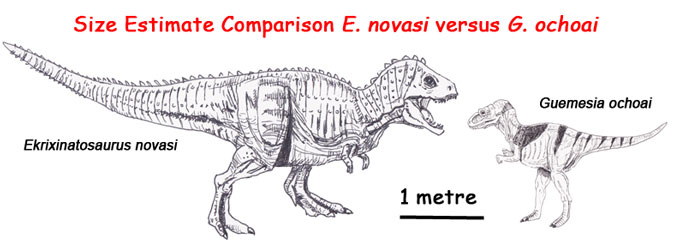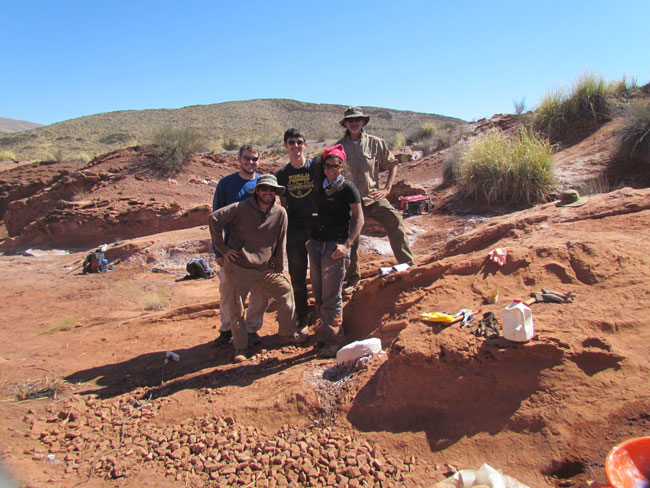A New Abelisaurid from North-western Argentina
Ask any dinosaur fan about the Abelisauridae and they are likely to mention Carnotaurus, Abelisaurus and even Ekrixinatosaurus – all large predators whose fossils were found in Argentina. Whilst it is true that the South American fossil record of these short-armed, blunt-headed theropods is largely restricted to Brazil and Argentina, abelisaurid fossil material is not uniformly distributed across Cretaceous-aged sediments in these two countries. For example, in Argentina, abelisaurid fossil discoveries tend to be found in the south, in Patagonia. However, a new abelisaurid discovery is changing perceptions.

The braincase fossil is 70% smaller than the braincase of other abelisaurs, suggesting that G. ochoai may be a diminutive form or perhaps the fossil material represents a juvenile. Size comparison between Guemesia ochoai (right) and the closely related Ekrixinatosaurus novasi (left) if specimen number IBIGEO-P 103 represents adult material. Picture credit: Everything Dinosaur.
Picture credit: Everything Dinosaur
Researchers writing in the “Journal of Vertebrate Paleontology”, have named a new abelisaurid taxon based on the discovery of a small braincase (fused skull bones which contained the brain, specimen number IBIGEO-P 103), in Salta Province in the far north-west of Argentina. The new dinosaur has been named Guemesia ochoai. Its discovery provides the first definitive evidence of the presence of these enigmatic theropods in this part of Argentina.
Patagonian abelisaurid fossils are relatively abundant and include extensively researched and partially complete specimens. In contrast, abelisaurids from north-western Argentina are represented by isolated bones and teeth, fossil material that is regarded as too scrappy to permit the erection of new taxa.
Los Blanquitos Formation
The nearly complete braincase comes from reddish sandy siltstone exposures in the Amblayo Valley (San Carlos department, Salta Province). The precise age of the fossil-bearing sediments is unknown, although radiometric dating studies of volcanic rocks associated with the top of the Los Blanquitos Formation indicate an age range of 69.5 to 70.5 million years, thus suggesting that these strata date from the Campanian/Maastrichtian.
Towards the end of the Mesozoic, rising sea levels led to the division of South America into several landmasses. A shallow sea separated the north-eastern part of the continent from the southern portion. The braincase autapomorphies established by CT-scan analysis undertaken at the TCba Salguero Diagnostic Centre in Buenos Aires, distinguish G. ochoai from Patagonian abelisaurids and its discovery supports the idea that distinct dinosaur communities existed in South America during the Late Cretaceous.
International Collaboration in the Hunt for Argentina’s Dinosaurs
The scientific paper, published in the Journal of Vertebrate Paleontology, provides an example of the extensive international collaboration between academics in a bid to discover more about the unusual dinosaur biota of northern Argentina.

The field team at the G. ochoai dig site in the Amblayo Valley. The fossil specimen can be seen in the foreground it is covered in its protective plaster jacket prior to its removal from the dig site. Back row, left to right, Andrew Cuff, Thomas Halliday and Javier Ochoa. Front row, left to right Agustín Scanferla and Anjali Goswami). Picture credit: Agustín Scanferla (Universidad Maimónides, Buenos Aires).
Picture credit: Agustín Scanferla (Universidad Maimónides, Buenos Aires)
Co-author of the scientific paper Dr Andrew Cuff (Human Anatomy Resource Centre, University of Liverpool), explained:
“I was lucky enough to be a member of the small team that was exploring the area and heard the excited shouts of Javier Ochoa [a technician at the Museo Regional “Florentino Ameghino,” Río Tercero city, Argentina] (who found the fossil), and Agustín Scanferla [Universidad Maimónides, Argentina]. They said they had found a skull. After getting a closer look at it I guessed that it might be an abelisaur braincase from the bits we could see, but at that stage it was very much a guess. We extracted the specimen from the ground back in 2015. Some beautiful, and I imagine very difficult preparation of the braincase (due to the bone looking very similar in colour to the rock), has since occurred.”
Dr Cuff added:
“This was followed up with CT scanning to get a look inside the braincase allowing more in-depth study of where the brain itself would have been. The Argentinian team has carried out a great study, and I feel very privileged to have been involved in a small way.”
A Diminutive Abelisaurid or a Juvenile
It remains uncertain as to whether the skull material represents a mature, diminutive theropod or the remains of a juvenile. The bones forming the braincase are tightly fused, but the authors urge caution when using bone fusion as the sole indicator of the age of an animal. Hopefully, postcranial material will be found such as limb bones that will permit a histological analysis.
Commenting on the possibility of further fossil finds from north-western Argentina, Dr Cuff added:
“There is certainly a lot more material to be found in Salta province that would further enrich our knowledge of the Argentinian dinosaur record. I hope that further exploration will help us fill in these gaps in the South American and Argentinian fossil record.”
Etymology for a New Abelisaurid
The genus name honours Governor of Salta Province and military leader General Martin Miguel de Güemes (1785-1821). The species name recognises the contribution made to vertebrate palaeontology by Javier Ochoa, who found the braincase fossil.
To read an article from 2021 about a newly described abelisaurid from Neuquén Province (northern Patagonia): Llukalkan aliocranianus.
New species of abelisaurid described from south-eastern Brazil: Kurupi itaata from the Marília Formation.
The scientific paper: “First definitive abelisaurid theropod from the Late Cretaceous of Northwestern Argentina” by Federico L. Agnolín, Mauricio A. Cerroni, Agustín Scanferla, Anjali Goswami, Ariana Paulina-Carabajal, Thomas Halliday, Andrew R. Cuff and Santiago Reuil published in the Journal of Vertebrate Paleontology.
Visit the Everything Dinosaur website: Everything Dinosaur.

